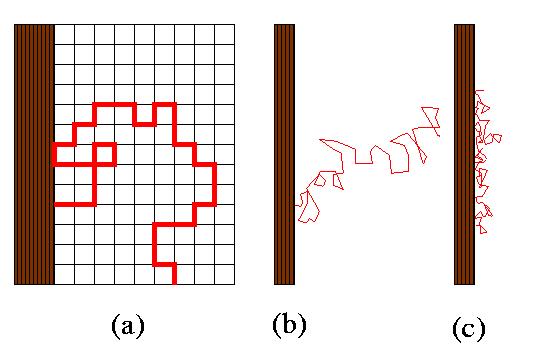Answer to the Question 09/02
POLYMER AT A WALLThe question was:

One of the simplest idealizations of a flexible polymer chain consists of replacing it by a random walk on a cubic lattice in three-dimensional space or on a square lattice in two-dimensional space. (This walk is allowed to self-intersect, and it has no "bending energy", i.e. each step is independent of the previous one.) An example of such "polymer" is depicted by a red line in Fig. (a). Assume that one end of the polymer is tied to a surface (denoted by brown color in the Figure). The surface will be considered adsorbing, i.e. every time the polymer (or the random walk) touches the surface its energy decreases by V. E.g., the energy of the configuration in Fig. (a) is -3V, because the walk touches the surface three times.
A very long polymer will be either localized near the surface as depicted in Fig. (c), or will be delocalized as in Fig. (b), depending on the temperature T. (Figs. (b) and (c) have different scale from Fig. (a) and therefore the lattice is not shown.)
Describe the temperature-dependence of the "localization" of the polymer.
(11/2003) The problem has been solved (6/10/03) by Yoram Burak from Tel Aviv University, Israel (e-mail yorambu@post.tau.ac.il) (see his solution in PDF format), and (17/10/03) by Oleg Semenov (Moscow, Russia) (e-mail sansparo@ktv.ru) (see his solution in PDF format). The solutions approach the problem from slightly different angles, but they both arrive at the same answer: the critical temperature is V/akB, where the numerical constant a=ln(4/3)=0.29.
 Back to "front page"
Back to "front page"